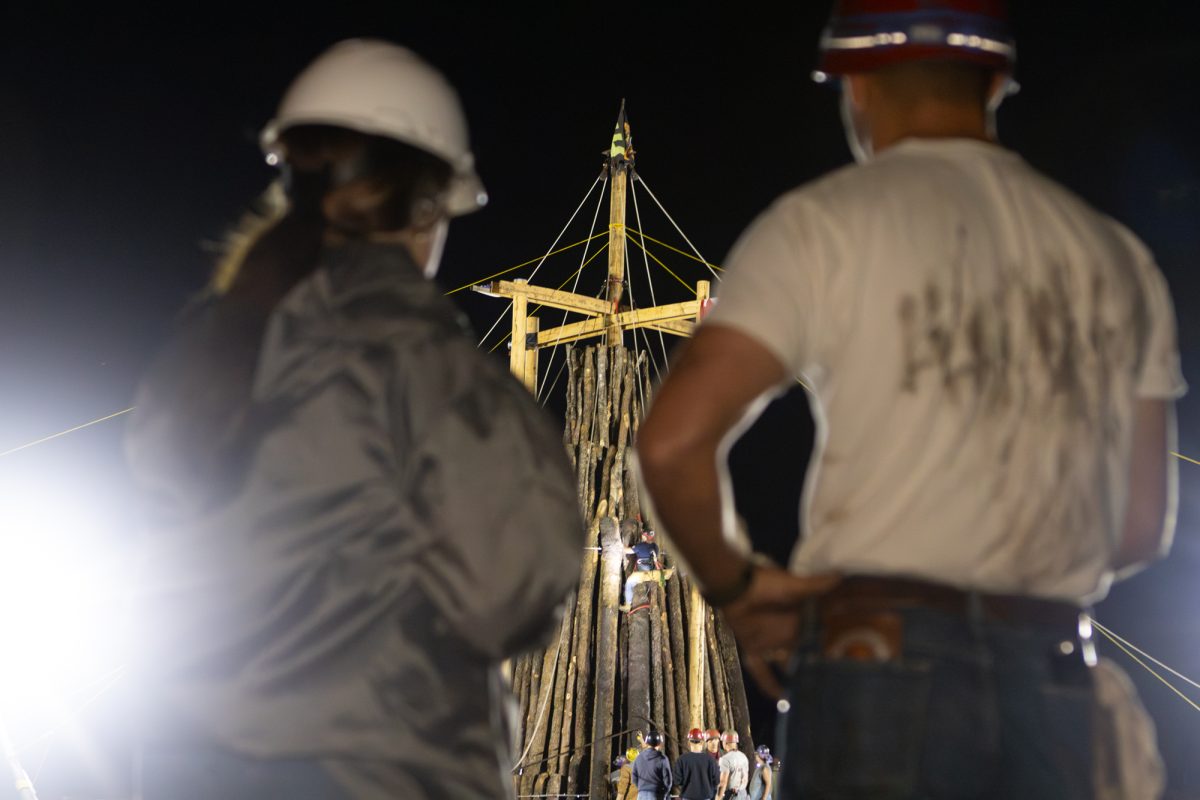The Battalion Assistant Life & Arts Editor Skye Lovelady sat down with Ann Goodman, associate director of the Department of Student Activities, who was one of the first people contacted when Bonfire collapsed on November 18th, 1999 at 2:42 a.m., to discuss her job and what she saw during those critical first hours.
THE BATTALION: What was your initial reaction when you received the page and then arrived on the scene?
GOODMAN: Well obviously it was a shock, just because I had been out there three hours before … and things were fine, things were going along like they normally had, and so when I got the call, I couldn’t imagine what I was going to see when I pulled up. And quite honestly you couldn’t see a lot, because the way the stack was built and the way the lighting was configured when the stack fell, it pulled all of the wires and all of the lights down. There was hardly any light. The only light that was there was the headlights and the lights from the emergency vehicles that were in the area. So it was really eerie.
THE BATTALION: What action did you take first, upon arriving?
GOODMAN: I just went on auto-pilot and tried to figure out what kind of information do I have access to? What kind of resources do I have that I can help with the rescue efforts?
THE BATTALION: So when you got there, you started to help rescue?
GOODMAN: I was a part of the Critical Incident Response Team, which is a group of individuals in Student Affairs… But back then it was a group of four people and I was carrying the pager for that week and so I got the page, and our process was as soon as we get a page, we arrived on scene and we would check in with the incident command … But I do remember Elmer Schneider, who was our chief of police from UPD, and Elmer pointed at me and said, ‘She will know all the student contacts that she can help coordinate with the students.’ Because at that point, we just needed to know who was there. They didn’t keep lists anywhere … My role was primarily working to figure out what students were out there and what students were not. So then we could start to go through and see who’s accounted for and who wasn’t.
THE BATTALION: What did you observe as far as student participation when you arrived on the scene?
GOODMAN: There weren’t that many students because it was the 3 o’clock shift. There was a decent number of students, but the vast majority of students that were there, they were on the stack, they weren’t out watching. A lot of them were trying to respond to the injured because there were 28 injured … Those people that were out there were either going with their friends to the hospitals or they were trying to help identify people who were still trapped in the logs.
THE BATTALION: Did you have to make “that call” to the families? Was that your job as part of the CIRT?
GOODMAN: It was not my job to call them. We had other CIRT members and people in the vice president’s office that made those phone calls. But many of [the families] just drove straight here, not knowing. They woke up at six in the morning hearing that the stack had collapsed, and by early that morning the phone lines were jammed … We identified about 4 o’clock that morning that we needed to have a family assembly point, and that became the MSC. What we told them to do was not to come to the site, because there was nothing they could do there. They all went to the MSC and there was a check in place … and when we couldn’t find them [students of the families] then generally it was a matter of identifying them out at the site and that’s what I had to go do … This was probably the toughest part, but we had bodies that we had to line up. We had created basically a makeshift morgue out of a bunch of Aggie busses. We kind of parked them in a square so that no one could see back there and we would walk the family members back there and they would either identify them. That was the tough part. Sometimes, if family members weren’t there, we had to use other students, and that was also tough.
THE BATTALION: What were some instances that you observed that most students haven’t heard before in those first few hours?
GOODMAN: Well unbeknownst to me, because I was out at the scene, there was a lot of things going on behind the scenes. You had a whole candlelight vigil being planned for the next night … [at] Reed Arena … you had President Bush 41 there in attendance. Rick Perry was there. You had a number of dignitaries who came just because, and all of that had been coordinated by students and attended by students. All while the recovery efforts were still going on … The students were trying to find a way to make sense of all this, all that was happening and they did it together.
Q&A: The critical hours after
November 17, 2017
Photo by Photo by Cassie Stricker
Ann Goodman was a part of the Critical Incident Response Team in 1999 and was one of the people who worked to figure out which students were on site and which were not the night the stack collapsed.
0
Donate to The Battalion
$2065
$5000
Contributed
Our Goal
Your donation will support the student journalists of Texas A&M University - College Station. Your contribution will allow us to purchase equipment and cover our annual website hosting costs, in addition to paying freelance staffers for their work, travel costs for coverage and more!
More to Discover
















